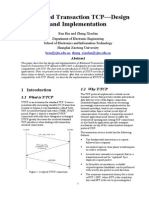Computer Networks (CS425) : Transport Layer Protocol-Implementation Issues
Uploaded by
Anish VeettiyankalComputer Networks (CS425) : Transport Layer Protocol-Implementation Issues
Uploaded by
Anish Veettiyankal11/8/2014
CS425: Computer Networks: Lecture 16
Computer Networks (CS425)
Instructor: Dr. Dheeraj Sanghi
Prev| Next| Index
Transport Layer Protocol- Implementation Issues
In this class we discussed about the TCP from the implementation point of view and addressed various
issues like state diagram and other details which TCP Standard does not define but supported by
commercial implementations.
State Diagram
The state diagram approach to view the TCP connection establishment and closing simplifies the design of
TCP implementation. The idea is to represent the TCP connection state, which progresses from one state to
other as various messages are exchanged. To simplify the matter, we considered two state diagrams, viz.,
for TCP connection establishment and TCP connection closing.
Fig 1 shows the state diagram for the TCP connection establishment and associated table briefly explains
each state.
TCP Connection establishment
The table gives brief description of each state of the above diagram.
State Description Table 1.
Represents the state when waiting for connection request from any remote
host and port. This specifically applies to a Server.
http://www.cse.iitk.ac.in/users/dheeraj/cs425/lec16.html
1/5
11/8/2014
Listen
Syn-Sent
CS425: Computer Networks: Lecture 16
From this state, the server can close the service or actively open a connection
by sending SYN.
Represents waiting for a matching for a connection request after having sent a
connection request. This applies to both server and client side. Even though
server is considered as the one with passive open, it can also send a SYN
packet actively.
Syn_Rcvd
Represents waiting for a confirmation connection request acknowledgment
after having both received and sent connection request.
Estab
Represents an open connection. Data transfer can take place from this point
onwards.
After the connection has been established, two end-points will exchange useful information and terminate
the connection. Fig. 2 shows the state diagram for terminating an active connection.
Fig 2. TCP Connection termination
FIN-WAIT-1
State Description Table 2
Represents connection termination request from the remote TCP peer, or an
acknowledgment of the connection termination request previously sent.
This state is entered when server issues close call.
http://www.cse.iitk.ac.in/users/dheeraj/cs425/lec16.html
2/5
11/8/2014
CS425: Computer Networks: Lecture 16
FIN-WAIT-2
Represents waiting for a connection termination request from the remote
TCP.
CLOSING
Represents connection termination request acknowledgment from the remote
TCP.
TIME_WAIT
This represents waiting time enough for the packets to reach their destination.
This waiting time is usually 4 min.
CLOSE_WAIT
Represents a state when the server receives a FIN from the remote TCP , sends
ACK and issues close call sending FIN
LAST_ACK
Represents waiting for an ACK for the previously sent FIN-ACK to the
remote TCP
CLOSE
Represents a closed TCP connection having received all the ACKs
Other implementation details
Quite Time
It might happen that a host currently in communication crashes and reboots. At startup time, all the data
structures and timers will be reset to an initial value. To make sure that earlier connection packets are
gracefully rejected, the local host is not allowed to make any new connection for a small period at startup.
This time will be set in accordance with reboot time of the operating system.
Initial Sequence number :
Initial sequence number used in the TCP communication will be initialized at boot time randomly, rather
than to 0. This is to ensure that packets from old connection should not interfere with a new connection. So
the recommended method is to
Initialize the ISN at boot time by a random number
For every 500 ms, increment ISN by 64K
With every SYN received, increment ISN by 64K
Maximum Request backlog at server
As we have seen in Unix Networking programming, listen(sd,n), sets a maximum to the number of
requests to be obliged by the server at any time. So if there are already n requests for connection, and n+1
request comes, two things can be done.
Drop the packet silently
Ask the peer to send the request later.
The first option is recommended here because, the assumption is that this queue for request is a coincident
http://www.cse.iitk.ac.in/users/dheeraj/cs425/lec16.html
3/5
11/8/2014
CS425: Computer Networks: Lecture 16
and some time later, the server should be free to process the new request. Hence if we drop the packet, the
client will go through the time-out and retransmission and server will be free to process it.
Also, Standard TCP does not define any strategy/option of knowing who requested the connection. Only
Solaris 2.2 supports this option.
Delayed Acknowledgment
TCP will piggyback the acknowledgment with its data. But if the peer does not have the any data to send at
that moment, the acknowledgment should not be delayed too long. Hence a timer for 200 ms will be used.
At every 200 ms, TCP will check for any acknowledgment to be sent and send them as individual packets.
Small packets
TCP implementation discourages small packets. Especially if a previous relatively large packet has been
sent and no acknowledgment has been received so far, then this small packet will be stored in the buffer
until the situation improves.
But there are some applications for which delayed data is worse than bad data. For example, in telnet, each
key stroke will be processed by the server and hence no delay should be introduced. As we have seen in
Unix Networking programming, options for the socket can be set as NO_DELAY, so that small packets are
not discouraged.
ICMP Source Quench
We have seen in ICMP that ICMP Source Quench message will be send for the peer to slow down. Some
implementations discard this message, but few set the current window size to 1.
But this is not a very good idea.
Retransmission Timeout
In some implementation (E.g.. Linux), RTO = RTT + 4 * delay variance is used to instead of constant 2.
Also instead of calculating RTT(est) from the scratch, cache will be used to store the history from which
new values are calculated as discussed in the previous classes.
Standard values for Maximum Segment Life (MSL) will be between 0.5 to 2 minutes and Time wait state
= f(MSL)
Keep Alive Time
Another important timer in TCP is keep alive timer. It is basically used by a TCP peer to check whether
the other end is up or down. It periodically checks this connection. If the other end did not respond, then
that connection will be closed.
Persist Timer
As we saw in TCP window management, when source sends one full window of packets, it will set its
window size to 0 and expects an ACK from remote TCP to increase its window size. Suppose such an
ACK has been sent and is lost. Hence source will have current window size = 0 and cannot send &
http://www.cse.iitk.ac.in/users/dheeraj/cs425/lec16.html
4/5
11/8/2014
CS425: Computer Networks: Lecture 16
destination is expecting next byte. To avoid such a deadlock, a Persist Timer will be used. When this timer
goes off, the source will send the last one byte again. So we hope that situation has improved and an ACK
to increase the current window size will be received.
References
http://www.ssfnet.org/Exchange/tcp/tcpTutorialNotes.html
back to top
Prev| Next | Index
http://www.cse.iitk.ac.in/users/dheeraj/cs425/lec16.html
5/5
You might also like
- PID Project Initiation Document Template PDF100% (1)PID Project Initiation Document Template PDF11 pages
- The Gilliam Autism Rating Scale GARS - 2 A Pilot S100% (1)The Gilliam Autism Rating Scale GARS - 2 A Pilot S2 pages
- Introduction To Linux: Kernel Network InterfaceNo ratings yetIntroduction To Linux: Kernel Network Interface13 pages
- Enhanced Transaction TCP-Design and Implementation: 1.1 What Is T/TCP 1.2 Why T/TCPNo ratings yetEnhanced Transaction TCP-Design and Implementation: 1.1 What Is T/TCP 1.2 Why T/TCP10 pages
- NS Simulation Implementing Large Window Over TCP SACKNo ratings yetNS Simulation Implementing Large Window Over TCP SACK5 pages
- Winsock Programmer's FAQ Articles: Debugging TCP/IPNo ratings yetWinsock Programmer's FAQ Articles: Debugging TCP/IP4 pages
- Computer Networks (CS425) : Transport Layer Protocol (Continued)No ratings yetComputer Networks (CS425) : Transport Layer Protocol (Continued)4 pages
- Design of A Wired Network Using Different TopologiesNo ratings yetDesign of A Wired Network Using Different Topologies12 pages
- NET102 WEEK-NO5 Role of TCP in Transport LayerNo ratings yetNET102 WEEK-NO5 Role of TCP in Transport Layer28 pages
- Take Asse Ssment - Enetwork Chapter 4 - Ccna Exploration: Network Fundamentals (Version 4.0)No ratings yetTake Asse Ssment - Enetwork Chapter 4 - Ccna Exploration: Network Fundamentals (Version 4.0)4 pages
- Effect of Maximum Congestion of TCP Reno in Decagon NoCNo ratings yetEffect of Maximum Congestion of TCP Reno in Decagon NoC5 pages
- Inter Process Communication (IPC) Between Processes On Different Hosts Over The Network. IPC Has Two FormsNo ratings yetInter Process Communication (IPC) Between Processes On Different Hosts Over The Network. IPC Has Two Forms33 pages
- Ex - No:5-C Date: Study of Udp/Tcp PerformanceNo ratings yetEx - No:5-C Date: Study of Udp/Tcp Performance16 pages
- Introduction To Networks Version 70 ITNv7 Practice Final Exam AnswersNo ratings yetIntroduction To Networks Version 70 ITNv7 Practice Final Exam Answers27 pages
- Analysis of TCP Reno With Two Packet Drops Without Maximum Congestion Window in Network On ChipNo ratings yetAnalysis of TCP Reno With Two Packet Drops Without Maximum Congestion Window in Network On Chip5 pages
- System Internal Controls Management AccountantsNo ratings yetSystem Internal Controls Management Accountants13 pages
- Study of TCP Throughput On Network Simulator Opnet++ by Using Different ParametersNo ratings yetStudy of TCP Throughput On Network Simulator Opnet++ by Using Different Parameters6 pages
- Internet and Internet Protocol Suite: Version 1 ECE, IIT KharagpurNo ratings yetInternet and Internet Protocol Suite: Version 1 ECE, IIT Kharagpur7 pages
- CISCO PACKET TRACER LABS: Best practice of configuring or troubleshooting NetworkFrom EverandCISCO PACKET TRACER LABS: Best practice of configuring or troubleshooting NetworkNo ratings yet
- WAN TECHNOLOGY FRAME-RELAY: An Expert's Handbook of Navigating Frame Relay NetworksFrom EverandWAN TECHNOLOGY FRAME-RELAY: An Expert's Handbook of Navigating Frame Relay NetworksNo ratings yet
- Computer Networks (CS425) : Unix Socket Programming (Contd..)No ratings yetComputer Networks (CS425) : Unix Socket Programming (Contd..)6 pages
- Computer Networking Interview Question and Answer PDFNo ratings yetComputer Networking Interview Question and Answer PDF30 pages
- Computer Networks (CS425) : Transport Layer ProtocolNo ratings yetComputer Networks (CS425) : Transport Layer Protocol3 pages
- Jason Dela Cruz Jose": IT Engineer / Systems EngineerNo ratings yetJason Dela Cruz Jose": IT Engineer / Systems Engineer3 pages
- Computer Networks (CS425) : Unix Socket ProgrammingNo ratings yetComputer Networks (CS425) : Unix Socket Programming4 pages
- Computer Networks (CS425) : ARP, RARP, ICMP ProtocolsNo ratings yetComputer Networks (CS425) : ARP, RARP, ICMP Protocols7 pages
- Computer Networks (CS425) : Data EncodingNo ratings yetComputer Networks (CS425) : Data Encoding7 pages
- Computer Networks (CS425) : Instructor: Dr. Dheeraj SanghiNo ratings yetComputer Networks (CS425) : Instructor: Dr. Dheeraj Sanghi7 pages
- Computer Networks (CS425) : Instructor: Dr. Dheeraj SanghiNo ratings yetComputer Networks (CS425) : Instructor: Dr. Dheeraj Sanghi6 pages
- Computer Networks (CS425) : ISO-OSI 7-Layer Network ArchitectureNo ratings yetComputer Networks (CS425) : ISO-OSI 7-Layer Network Architecture5 pages
- Computer Networks (CS425) : Routing AlgorithmsNo ratings yetComputer Networks (CS425) : Routing Algorithms5 pages
- Computer Networks (CS425) : IEEE 802.3 and EthernetNo ratings yetComputer Networks (CS425) : IEEE 802.3 and Ethernet3 pages
- COMMS207 Research Worksheet #2 Jade JugumNo ratings yetCOMMS207 Research Worksheet #2 Jade Jugum2 pages
- Gastro-Intestinal System Diagnostic TestsNo ratings yetGastro-Intestinal System Diagnostic Tests11 pages
- Tax Planning in Case of Foreign Collaborations and Joint VentureNo ratings yetTax Planning in Case of Foreign Collaborations and Joint Venture3 pages
- Orthoptic Exercises Information Leaflet: OphthalmologyNo ratings yetOrthoptic Exercises Information Leaflet: Ophthalmology5 pages
- UNIT 3 - Information Technology System Applicable in Nursing Practice100% (3)UNIT 3 - Information Technology System Applicable in Nursing Practice85 pages
- 3ms All Sequences Lesson Plans Worksheets Tutorial SessionsNo ratings yet3ms All Sequences Lesson Plans Worksheets Tutorial Sessions110 pages
- Learn: Half Yearly Examination (2013 - 2014) Class Ix Foundation of Information Technology Time: 3 Hrs. M.M.: 90No ratings yetLearn: Half Yearly Examination (2013 - 2014) Class Ix Foundation of Information Technology Time: 3 Hrs. M.M.: 9023 pages
- PM Reyes Notes On Taxation 2 - Valued Added Tax (Working Draft)100% (1)PM Reyes Notes On Taxation 2 - Valued Added Tax (Working Draft)22 pages
- CV For Road Safety Specialist - PDF - CompressedNo ratings yetCV For Road Safety Specialist - PDF - Compressed8 pages
- Pengaruh Atribut Produk Rotiboy Terhadap Kepuasan Konsumen Di Mall Ciputra SemarangNo ratings yetPengaruh Atribut Produk Rotiboy Terhadap Kepuasan Konsumen Di Mall Ciputra Semarang9 pages
- Review Notes in Working Papers Review Notes in Working PapersNo ratings yetReview Notes in Working Papers Review Notes in Working Papers16 pages
- Multicast Part of The CCIE EI Workbook Orhan ErgunNo ratings yetMulticast Part of The CCIE EI Workbook Orhan Ergun32 pages
- The Gilliam Autism Rating Scale GARS - 2 A Pilot SThe Gilliam Autism Rating Scale GARS - 2 A Pilot S
- Enhanced Transaction TCP-Design and Implementation: 1.1 What Is T/TCP 1.2 Why T/TCPEnhanced Transaction TCP-Design and Implementation: 1.1 What Is T/TCP 1.2 Why T/TCP
- NS Simulation Implementing Large Window Over TCP SACKNS Simulation Implementing Large Window Over TCP SACK
- Winsock Programmer's FAQ Articles: Debugging TCP/IPWinsock Programmer's FAQ Articles: Debugging TCP/IP
- Computer Networks (CS425) : Transport Layer Protocol (Continued)Computer Networks (CS425) : Transport Layer Protocol (Continued)
- Design of A Wired Network Using Different TopologiesDesign of A Wired Network Using Different Topologies
- Take Asse Ssment - Enetwork Chapter 4 - Ccna Exploration: Network Fundamentals (Version 4.0)Take Asse Ssment - Enetwork Chapter 4 - Ccna Exploration: Network Fundamentals (Version 4.0)
- Effect of Maximum Congestion of TCP Reno in Decagon NoCEffect of Maximum Congestion of TCP Reno in Decagon NoC
- Inter Process Communication (IPC) Between Processes On Different Hosts Over The Network. IPC Has Two FormsInter Process Communication (IPC) Between Processes On Different Hosts Over The Network. IPC Has Two Forms
- Introduction To Networks Version 70 ITNv7 Practice Final Exam AnswersIntroduction To Networks Version 70 ITNv7 Practice Final Exam Answers
- Analysis of TCP Reno With Two Packet Drops Without Maximum Congestion Window in Network On ChipAnalysis of TCP Reno With Two Packet Drops Without Maximum Congestion Window in Network On Chip
- Study of TCP Throughput On Network Simulator Opnet++ by Using Different ParametersStudy of TCP Throughput On Network Simulator Opnet++ by Using Different Parameters
- Internet and Internet Protocol Suite: Version 1 ECE, IIT KharagpurInternet and Internet Protocol Suite: Version 1 ECE, IIT Kharagpur
- CCNA Interview Questions You'll Most Likely Be AskedFrom EverandCCNA Interview Questions You'll Most Likely Be Asked
- CISCO PACKET TRACER LABS: Best practice of configuring or troubleshooting NetworkFrom EverandCISCO PACKET TRACER LABS: Best practice of configuring or troubleshooting Network
- WAN TECHNOLOGY FRAME-RELAY: An Expert's Handbook of Navigating Frame Relay NetworksFrom EverandWAN TECHNOLOGY FRAME-RELAY: An Expert's Handbook of Navigating Frame Relay Networks
- Computer Networks (CS425) : Unix Socket Programming (Contd..)Computer Networks (CS425) : Unix Socket Programming (Contd..)
- Computer Networking Interview Question and Answer PDFComputer Networking Interview Question and Answer PDF
- Computer Networks (CS425) : Transport Layer ProtocolComputer Networks (CS425) : Transport Layer Protocol
- Jason Dela Cruz Jose": IT Engineer / Systems EngineerJason Dela Cruz Jose": IT Engineer / Systems Engineer
- Computer Networks (CS425) : Unix Socket ProgrammingComputer Networks (CS425) : Unix Socket Programming
- Computer Networks (CS425) : ARP, RARP, ICMP ProtocolsComputer Networks (CS425) : ARP, RARP, ICMP Protocols
- Computer Networks (CS425) : Instructor: Dr. Dheeraj SanghiComputer Networks (CS425) : Instructor: Dr. Dheeraj Sanghi
- Computer Networks (CS425) : Instructor: Dr. Dheeraj SanghiComputer Networks (CS425) : Instructor: Dr. Dheeraj Sanghi
- Computer Networks (CS425) : ISO-OSI 7-Layer Network ArchitectureComputer Networks (CS425) : ISO-OSI 7-Layer Network Architecture
- Computer Networks (CS425) : IEEE 802.3 and EthernetComputer Networks (CS425) : IEEE 802.3 and Ethernet
- Tax Planning in Case of Foreign Collaborations and Joint VentureTax Planning in Case of Foreign Collaborations and Joint Venture
- Orthoptic Exercises Information Leaflet: OphthalmologyOrthoptic Exercises Information Leaflet: Ophthalmology
- UNIT 3 - Information Technology System Applicable in Nursing PracticeUNIT 3 - Information Technology System Applicable in Nursing Practice
- 3ms All Sequences Lesson Plans Worksheets Tutorial Sessions3ms All Sequences Lesson Plans Worksheets Tutorial Sessions
- Learn: Half Yearly Examination (2013 - 2014) Class Ix Foundation of Information Technology Time: 3 Hrs. M.M.: 90Learn: Half Yearly Examination (2013 - 2014) Class Ix Foundation of Information Technology Time: 3 Hrs. M.M.: 90
- PM Reyes Notes On Taxation 2 - Valued Added Tax (Working Draft)PM Reyes Notes On Taxation 2 - Valued Added Tax (Working Draft)
- Pengaruh Atribut Produk Rotiboy Terhadap Kepuasan Konsumen Di Mall Ciputra SemarangPengaruh Atribut Produk Rotiboy Terhadap Kepuasan Konsumen Di Mall Ciputra Semarang
- Review Notes in Working Papers Review Notes in Working PapersReview Notes in Working Papers Review Notes in Working Papers
- Multicast Part of The CCIE EI Workbook Orhan ErgunMulticast Part of The CCIE EI Workbook Orhan Ergun















































































































